The ADATA Ultimate SU800 SSD Review (128GB, 256GB, 512GB)
by Billy Tallis on February 1, 2017 12:01 PM ESTAnandTech Storage Bench - The Destroyer
The Destroyer is an extremely long test replicating the access patterns of very IO-intensive desktop usage. A detailed breakdown can be found in this article. Like real-world usage and unlike our Iometer tests, the drives do get the occasional break that allows for some background garbage collection and flushing caches, but those idle times are limited to 25ms so that it doesn't take all week to run the test.
We quantify performance on this test by reporting the drive's average data throughput, a few data points about its latency, and the total energy used by the drive over the course of the test.
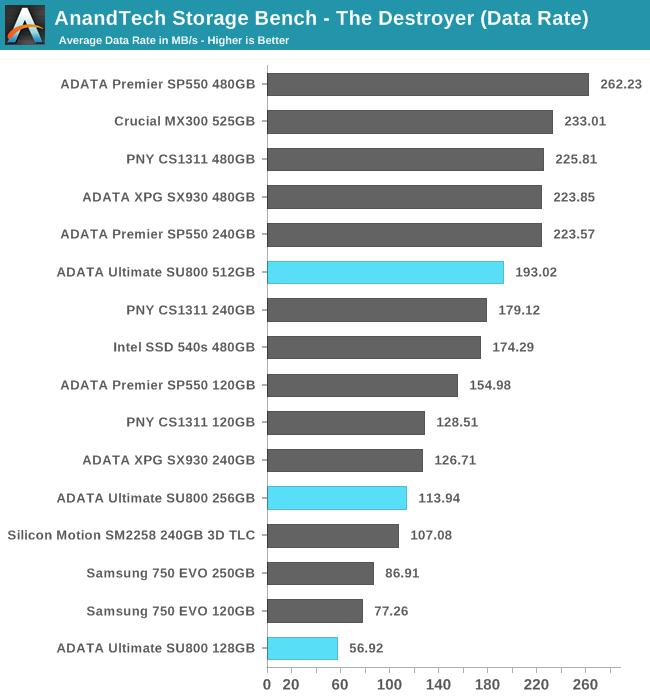
The average data rates delivered by the ADATA SU800 are slower than most of its competition, but it is improved over the earlier engineering sample from Silicon Motion and the Intel 540s that paired the SM2258 controller with SK Hynix 16nm TLC.
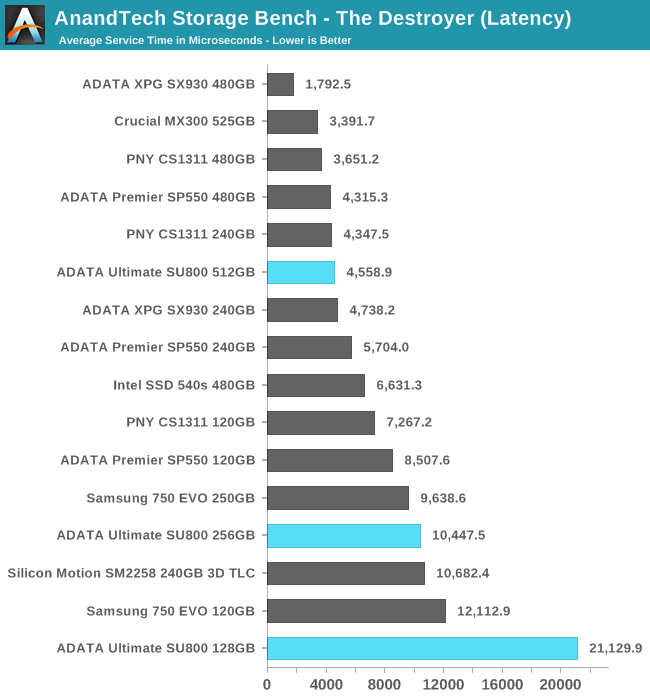
Latency is a weak point for the SU800, with average service times that are higher than almost all of its competition. The 128GB SU800 suffers the most, with an average over 21ms.
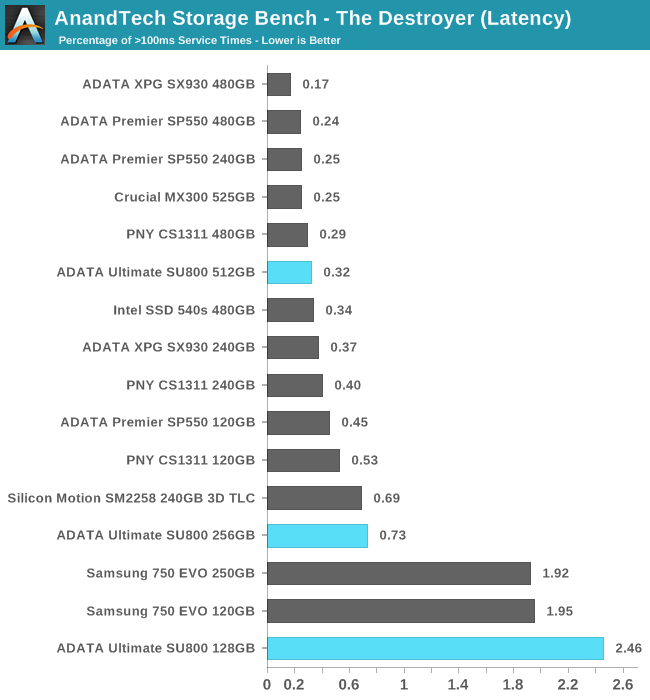
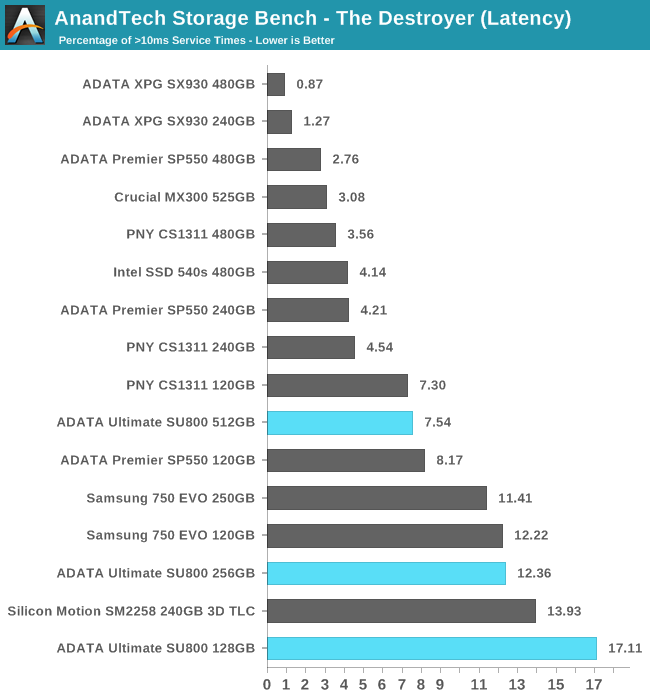
Aside from the smallest 128GB capacity, the SU800 doesn't have too many operations that take more than 100ms to complete, but at the 10ms threshold all three capacities rank poorly against the competition.
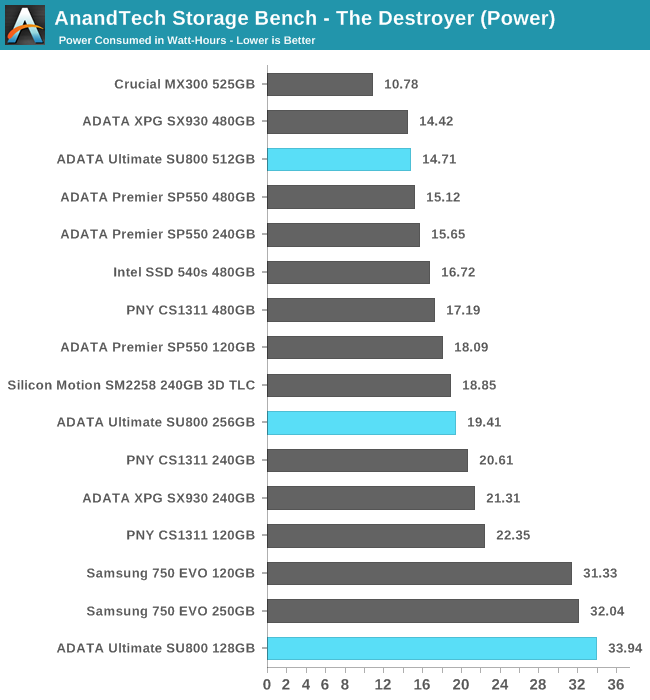
With so much time spent bogged down by garbage collection, it is no surprise that the smaller capacities of the SU800 use somewhat more power than most of the competition. The 512GB SU800 compares favorably against the planar TLC competition, but doesn't come close to the efficiency of the Crucial MX300.










35 Comments
View All Comments
RamIt - Wednesday, February 1, 2017 - link
Why is there no comparison to the Intel 600p recently reviewed?extide - Thursday, February 2, 2017 - link
Probably because it is a PCIe drive. A shopper who is shopping for SATA drives is probably not interested in a PCIe drive.dj_aris - Thursday, February 2, 2017 - link
Sorry, but since all SATA 3 drives top at theoretical 600MBs but SSD speeds are WAY faster than that, what is the point in testing them?Death666Angel - Thursday, February 2, 2017 - link
It might just be my eyes, but I see a lot of instances where the drives don't actually achieve the 600MB/s data cap of the SATA3 protocol....dj_aris - Thursday, February 2, 2017 - link
Indeed, but who cares if it's 600 or 500 or even 300, when you can reach 2000+ using modern pcie storage (with similiar prices). SATA is dead, obviously will not be developed anymore, SATA express drives don't even exist. I mean we don't test DVD drives or floppies, right?doggface - Thursday, February 2, 2017 - link
Sata is dead? Seriously?Also, similar prices?
So many things wrong with this post.
Sata SSDs will continue to thrive for years to come. No doubt about that, and while they do, we will need reviews on their performance to help differentiate the good from bad. Especially as the industry continues to peddle TLC and even possibly QLC drives.
vladx - Thursday, February 2, 2017 - link
Upcoming QLC NAND is not something to scowl at. SSD drives using this technology will not be targeted to compete with MLC or even TLC instead they are planned for archival purposes: https://www.pcper.com/news/Storage/FMS-2015-Toshib...Billy Tallis - Thursday, February 2, 2017 - link
SATA isn't dead, but it is a dead end in the same sense that VGA ports are.extide - Thursday, February 2, 2017 - link
Not everyone's system is compatible with and/or cannot boot from NVME drives. There is definitely still a need to have these data points.lopri - Thursday, February 2, 2017 - link
Two of my boards refuse to accept any M.2 drive as a boot drive, leaving me no choice but to go with SATA. Plus SATA is nowhere near dead because it is still much more affordable. Plus there is no convincing argument as to why backups have to be saved in SSDs.